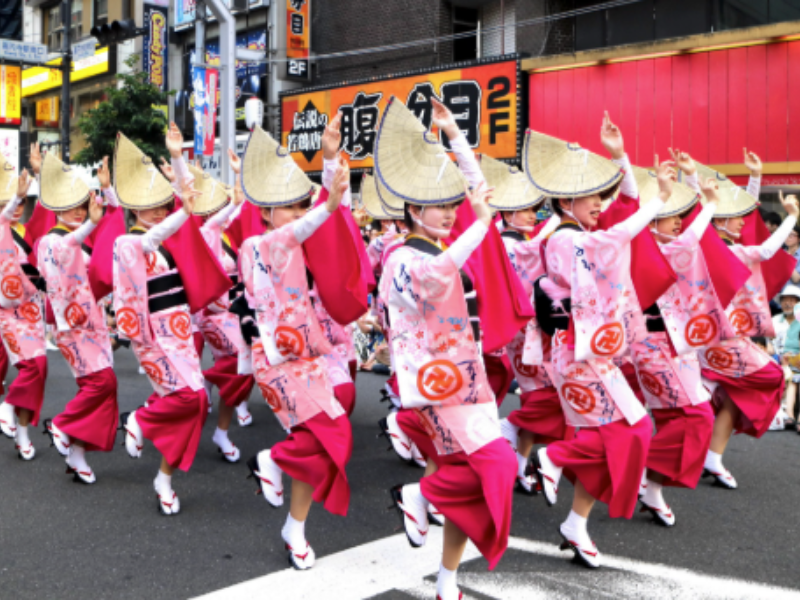Summer in Japan is more than fireworks and food stalls — it’s a season alive with matsuri (festivals) that celebrate community, culture, and tradition. Among them, few are as electrifying as Awa Odori, the “Dance of Awa,” held each August in Tokushima on Shikoku Island.
If you’ve ever dreamed of being swept into a whirl of music, colour, and joyful chaos, the Awa Odori Festival is an experience not to be missed. With its infectious rhythms, centuries-old traditions, and welcoming atmosphere, this festival is more than a performance — it’s a living, breathing celebration of Japanese spirit.
In this article, we’ll dive into the history of Awa Odori, what makes it so unique, what to expect if you go, and tips for making the most of your summer adventure in Tokushima.
A Festival Born from History
The origins of Awa Odori stretch back more than 400 years to the late 16th century. Legend has it that when Lord Hachisuka Iemasa built Tokushima Castle in 1586, he threw a massive party to celebrate. The townspeople drank sake, played shamisen and taiko, and danced wildly in the streets. This joyous event supposedly became the foundation of the Awa Odori tradition.
The word Awa refers to the old name for Tokushima Prefecture, while Odori simply means “dance.” What began as spontaneous street revelry has since evolved into one of Japan’s most famous summer festivals, drawing over 1 million visitors annually.
At its core, though, Awa Odori retains its spirit of unrestrained fun. Unlike some Japanese festivals that are solemn or ritualistic, Awa Odori is about letting loose. The chant that echoes through the streets says it best:
“The dancers are fools. The watchers are fools. If both are fools, you might as well dance!”
This simple yet powerful phrase captures the essence of the festival — a joyful invitation to join in.
#dearasia_london
Cultural Events
Explore our open events that immerse you in the vibrant celebrations of Asian cultures, right here in London. Join us to experience the rich traditions and festive spirit of various Asian communities.

The Dance of Awa: What Makes It Special
The Awa Odori dance is instantly recognizable. Dancers move in rhythmic steps, bending their knees and swinging their arms in time with the music. Men dance with bold, exaggerated movements, while women dance with elegance, often wearing woven straw hats (amigasa) tilted low over their faces.
The music is equally distinctive:
- Shamisen (three-stringed lute)
- Shinobue (flute)
- Taiko (drums)
- Kane (bell)
Together, they create a fast-paced, hypnotic rhythm that drives the dancers forward through the streets.
Groups of dancers, known as ren, practice all year for the big event. Each ren has its own style, costume, and choreography, ranging from traditional to contemporary. Some perform with disciplined precision, while others embrace playful improvisation. The variety makes watching (and joining!) endlessly entertaining.
When and Where to Experience Awa Odori
The Awa Odori Festival takes place every year from August 12 to 15 in Tokushima City. During these four nights, the city transforms into one giant stage, with dancers parading down the main streets and smaller performances popping up across town.
The festival is divided into two main types of performances:
- Street Parades (Nagashi Odori): These are the heart of the festival, where ren groups dance through downtown Tokushima while crowds cheer from the sidewalks.
- Stage Performances (Enbujo): Held at indoor or ticketed venues, these shows offer a closer look at professional ren performances, perfect for appreciating the artistry of the dance.
If you can’t make it to Tokushima in August, don’t worry — Awa Odori is so beloved that smaller versions are performed in Tokyo (Koenji Awa Odori) and other parts of Japan throughout the summer.
The Atmosphere: A City Alive with Energy
Imagine this: the sun sets, lanterns light up the streets, and the air fills with the rhythm of drums and flutes. Crowds gather, food stalls open, and the first ren of dancers appears, moving in unison as the crowd claps along. The atmosphere is electric, festive, and completely immersive.
Unlike many traditional festivals where the audience plays a passive role, Awa Odori thrives on interaction. Spectators are often invited to join the dance — and many do, laughing and stumbling through the steps before quickly catching the rhythm.
Food stalls line the streets, offering summer festival classics like:
- Yakitori (grilled chicken skewers)
- Takoyaki (octopus balls)
- Kakigori (shaved ice with syrup)
- Tokushima’s specialty: sudachi citrus drinks
Everywhere you turn, there’s music, dance, and laughter. It’s not just an event; it’s a sensory feast.
#dearasia_london
Asian Social Events
Find one of our social events to meet other like-minded people from our community

How to Join the Dance Yourself
The best part about Awa Odori is that you don’t just watch, you can participate. While most ren groups are made up of trained dancers, there are also niwaka ren (casual dance troupes) open to anyone. For a small fee, you can rent a yukata or happi coat, learn the basic steps, and join the parade.
It’s an unforgettable way to truly feel the spirit of the festival. Don’t worry about being perfect — remember the saying: “If both are fools, you might as well dance!”
Tips for Enjoying Awa Odori
If you’re planning to attend, here are some practical tips to make your experience smooth:
- Book Early: Hotels in Tokushima fill up months in advance, so reserve accommodations as early as possible.
- Arrive Before Sunset: Performances begin in the evening, but arriving early lets you explore food stalls and secure a good viewing spot.
- Buy Tickets for Reserved Seats: While street parades are free, paid seating in main venues guarantees a better view.
- Stay Hydrated: August in Japan is hot and humid — bring water and a fan.
- Try the Local Cuisine: Don’t miss Tokushima ramen, famous for its rich broth and raw egg topping.
Beyond the Festival: Exploring Tokushima
While the Awa Odori Festival is the star attraction, Tokushima offers much more for visitors:
- Mount Bizan: Take the ropeway up for panoramic views of Tokushima City and the Yoshino River.
- Awa Odori Kaikan: A museum dedicated to the festival, where you can learn the history and even try the dance year-round.
- Naruto Whirlpools: A natural wonder caused by tidal currents in the Naruto Strait, just a short trip from Tokushima.
- Local Crafts: Tokushima is known for indigo dyeing (Awa-ai), which you can try in workshops.
Making time for these attractions adds depth to your festival trip and showcases Shikoku’s unique charm.
Why Awa Odori Captures the Heart
What makes Awa Odori so captivating is its blend of tradition and spontaneity. Unlike festivals bound by strict rituals, this one celebrates imperfection, joy, and participation.
The music is fast and infectious, the dance steps simple enough for anyone to join, and the atmosphere so warm that even shy travelers find themselves clapping and swaying along. It’s not just about watching, it’s about becoming part of the celebration.
Awa Odori reminds us that festivals are not only cultural artefacts but living traditions that continue to evolve and bring people together.
Dance Like Nobody’s watching
The Awa Odori Festival is more than an event — it’s an invitation. To laugh, to dance, to celebrate life alongside strangers who quickly feel like friends. Whether you’re an experienced traveler to Japan or a first-time visitor, joining this summer spectacle in Tokushima is a memory you’ll carry forever.
So, the next time you find yourself in Japan during August, remember the chant:
“The dancers are fools. The watchers are fools. If both are fools, you might as well dance!”
Take that as your cue to step into the street, move to the rhythm, and discover the joy of Awa Odori for yourself.
#dearasia_london
Sign up to our Newsletter
No spam, we only send you seasonal promos and social events if you’d like to stay in touch.





